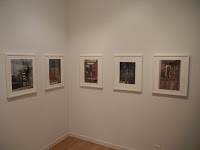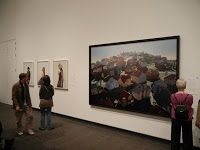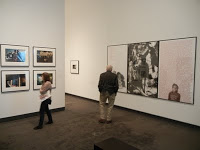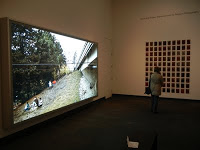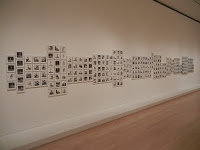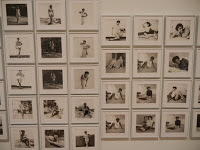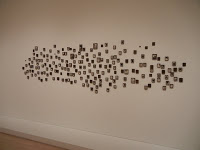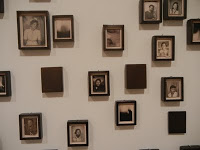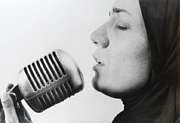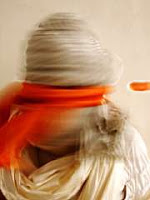JTF (just the facts): A retrospective exhibit of roughly 190 photographs, variously framed and matted, and hung against grey partitions in a series of 6 adjacent rooms and their side walls. Given the large number and wide range of works on display, I have noted the details (as available) on a room by room basis:
Room 1: 11 gum prints, 1981
Room 2: 23 c-prints, 1979-1980; 1 glass case of collage pages
Room 3: 17 Polaroids, each roughly 3×4, some toned, 1985/undated
Room 4: 44 Polaroids, each roughly 3×4, interspersed with 7 larger toned gelatin silver prints, 1979-1989
Room 5: 31 prints in a variety of processes, including colorized/toned gelatin silver, c-print photograms, gelatin silver photograms, gelatin silver x-rays and other combinations, 1986-1987; 3 glass cases of magazines, cut-outs, collages, drawings, and journal pages
Room 6: 59 c-print negative sandwiches, some with ink, marker, or other residues along the border areas, hung in large grids, 1982-1988
Side wall of last room: 1 c-print, 1 c-print negative, 1 Polaroid, 1 gelatin silver print
Unfortunately, no photography was allowed in the galleries, so there are no installation shots for this review.
Comments/Context: First, let’s start with an admission. Prior to walking into this show, I really hadn’t ever heard of Mark Morrisroe. If you read the many features, reviews, and articles about this exhibit (several linked below), you’ll find that nearly all of them lead in with a retelling of the back story of Morrisroe’s life, a now seemingly mythical/tragic/nostalgic story of living fast and dying young. But I didn’t steep myself in this cult of personality until after I saw the show, so what follows is really a response to the photography itself, irrespective of the trajectory of his famously short life (he died of AIDS at the age of 30 in 1989).
While Morrisroe’s artistic output was surprisingly diverse, I think it is possible to synthesize it down into three major categories, with some intermixing and overlap between the three buckets: color candids, black and white Polaroids (primarily nudes, portraits, and self portraits), and process experiments. Morrisroe’s color photographs are generally taken with a Nan Goldin-like snapshot aesthetic, most being casual portraits of people in and around his particular social scene, many preening and performing for the camera. Exuberance and self-consciousness are mixed in equal parts in his subjects’ experimentation with different invented personas, genders, and personalities.
Morrisroe’s smaller black and white work is altogether more inward and personal, his search for identity captured in different facets of emotion. Shadows and blurs add a layer of romantic elegance to simple shots of Morrisroe and his friends and lovers, often seen in his bedroom or apartment staring into the camera in a variety of moods. These photographs are close in, the nudes both authentic and informal, running the gamut of the playful and provocative in his early days to the harrowing, emaciated decay of the later years. In some of the works, Morrisroe modified the surface of the picture, adding faint toning or washes of chemicals, further softening and obscuring the crisp reality. All of these images, and particularly the self-portraits, have a time capsule immediacy, where gritty, atmospheric moments are captured and then gone, the desires wispy and ephemeral.
I was most impressed with Morrisroe’s wide ranging experiments with photographic process. He seems to have been a bit of a mad scientist, combining and recombining elements of collage and photogram in ever more complex compositions, adding layers of gay porn magazine cutouts and object silhouettes to both black and white and color designs. He even found a way to incorporate some of his own x-rays and dental records into these vivid inventions. The end result is somewhat reminiscent of a more intimate and personal Robert Heinecken, but with brighter, more acidic colors. His “negative sandwich” prints have a more indistinct, almost gestural quality, the nudes and still lifes darker and fuzzier, often with tone-matched scratchings and crude notations drawn all over the borders and edges like simplistic graffiti. The last two rooms of the show that house these process-centric works seem to have an almost manic quality, of an artist brimming with ideas and struggling to edit and make sense of them all. I would certainly enjoy seeing a deeper, more systematic exploration of these particular images, as I think they display the most raw, unchanneled, innovation.
All in, this expansive retrospective depicts Morrisroe as part social animal, part shape shifting searcher, and part lively artistic experimenter, and successfully places some order and context around his various bodies of work. Having seen this show, I think I can now more accurately categorize Morrisroe in the larger field if 1980s photography, and better understand his connections to Mapplethorpe and others. I also came away with the itching, unanswerable question of what unexpected surprises this man might actually have been capable of, had he been given more time to refine and evolve his artistic vision; there’s undeniably a nugget of something unique here, it just hasn’t been clarified and synthesized into something altogether more potent.
Collector’s POV: Given that this is a museum-style exhibit, the prints in this show are obviously not for sale. Morrisroe’s photographs haven’t yet found their way to the secondary markets, so gallery retail is really the only option for interested collectors at this point. ClampArt (here) has a parallel show of Morrisroe’s work on view through April 30th.
Rating: ** (two stars) VERY GOOD (rating system described here)
Transit Hub:
- Feature: Art in America (here)
- Reviews: New Yorker (here), Village Voice (here), Artnet (here), Photo Booth (here), T magazine (here)
Mark Morrisroe: From This Moment On
Through May 1st
Artists Space
38 Greene Street
3rd Floor
New York, NY 10013
(As an aside, this show is the year-to-date leader in the most unhelpful staff category. No, I could not carry my bag with me I must put it near the desk, no I could not take any photographs, no, there were no installation shots readily available, no, there was no catalogue, no, there was no detailed checklist with item by item information, just look at the wall labels sir, followed by an unfriendly annoying blank-eyed shrug. This isn’t a major museum venue, and given the irksome reception, I was nanoseconds away from walking straight back out. So if my tone here is a bit more surly than usual, chalk it up to a piece that tried hard not to be written.)
